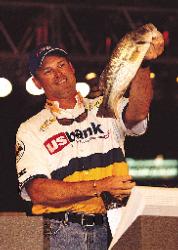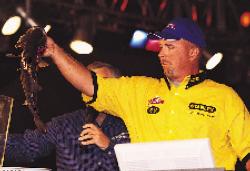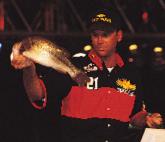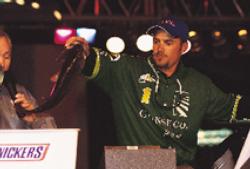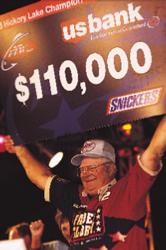Bacon smoked Hickory
The old guard showed the young guns how it's done on Old Hickory

Scientists seeking the youth gene – that miraculous hormone or chromosome that keeps humans youthful for years beyond their age – might consider sampling some of Basil Bacon’s blood.
At 65, Bacon still holds his own in one of the most grueling competitive sports on the planet – competitive bass fishing. Younger competition, savvy and energetic, does not put a ruffle in Bacon’s omnipresent Ranger Boats mesh cap. He still gets up before dawn, puts in 10 hours of hard fishing and goes to bed long after dark, just like his competitors, some of whom are half his age.
In May, the Springfield, Mo., angler proved his fishing mettle when he won the Wal-Mart FLW Tour stop on Old Hickory Lake outside Nashville, Tenn.
Bacon is more than a tournament veteran; he has outlived the term “bass-fishing legend.” Bacon now qualifies as a bass-fishing historian.
A trip back through the bass-fishing annals with Bacon would require going to a time before LCRs, LCDs and GPSs. You would have to travel back in time beyond fiberglass bass boats with livewells and trolling motors. Don’t bother stopping at the advent of “universal” bass fishing techniques like Texas rigs or Carolina rigs, either. In fact, go on back past the invention of soft plastic worms and monofilament line.
Heck, in order to go “back in the day” with Bacon, you would have to travel to a time before lakes. Okay, maybe not that far, but almost. Many of the reservoirs built by the Tennessee Valley Authority and the Army Corps of Engineers were filled during the ’50s and ’60s (including Old Hickory).
Bacon’s love affair with bass fishing began in the early ’60s. He remembers when a 16-foot aluminum V-hull with a 50 horsepower outboard was the top of the line in performance boating. His first fishing reels reeled backwards, and his first fishing line was nylon cord.
Bacon’s first lures? He hand-whittled them out of balsa, wrapped them in foil for scales, painted them with clear resin, inserted plastic lips made from a silver-dollar holder and attached a couple of hooks.
“We didn’t have patterns back then,” Bacon said with a laugh. “We just had `good spots.'”
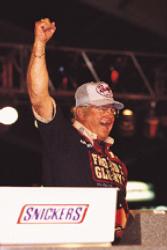 Bacon himself is responsible for helping to refine a few well-known bass-fishing techniques. Anglers who like to flip can thank Bacon for popularizing the technique.
Bacon himself is responsible for helping to refine a few well-known bass-fishing techniques. Anglers who like to flip can thank Bacon for popularizing the technique.
In fact, Bacon’s flipping expertise was a component of his win at Old Hickory. His confidence in the technique helped him parry hard charges from some of the younger competitors – most of who were still in diapers when Bacon was fishing his first tournament.
The lake
Old Hickory Lake is a TVA impoundment formed by the Cumberland River. The lake is roughly 25,000 acres in size. Similar to its TVA cousins throughout Tennessee and Alabama, Old Hickory is a riverine impoundment. Approximately 80 percent of the lake is the winding Cumberland River channel and its adjacent flats. The lower end of the reservoir has a handful of creeks that add body to the lake.
Cover in the lake is also similar to other TVA impoundments. Old Hickory contains vegetation, boat docks, riprap, seawalls and hundreds of shallow logs lodged in mudflats.
The water color is “TVA green,” and it fluctuates on a daily basis. Four to 10 inches of fluctuation in a day’s time is not uncommon.
Conditions
May 15-18, 2002, marked the first time that the FLW Tour visited Old Hickory. But it was not a first-time visit for some of the more seasoned bass pros. Old Hickory has been a popular stop on other national fishing circuits as well.
Before the event got under way, pros were moaning about Old Hickory’s miserly waters. Many had experienced poor fishing and a lack of quality bass in previous tournaments, and that was with a 12-inch limit. Now Old Hickory has a 14-inch minimum size limit.
“The last time I fished here, a 12-incher was hard to come by, and a 14-incher was considered a lunker,” said one pro.
But bassing veterans and Old Hickory rookies were in for a surprise when the FLW bus stopped at Gallatin, Tenn. At the day-one weigh-in, it was obvious that fishing had greatly improved on Old Hickory. Ranger pro Rob Kilby of Hot Springs, Ark., came to the scales with a five-bass limit weighing a whopping 23 pounds, 1 ounce – the biggest stringer of the entire FLW season.
Day two proved that Old Hickory’s good fishing was no fluke. Yamaha pro Brent Chapman of Shawnee, Kan., led the field with a two-day total of 30 pounds, 3 ounces. The top-20 cut, which some pros had prognosticated to be about 17 to 18 pounds, ended up being nearly 20 pounds.
Even when day three brought heavy rain and day four brought colder temperatures and the highest water of the event, finalists continued to haul in limits.
Dominant patterns
No one lure or technique was a prevalent producer at Old Hickory. Pros reported catching bass on just about every lure a tackle box will hold. Some pros even scored limits on top-water scum frogs.
As a testament to the number of lures that worked, fourth-place finisher Koby Kreiger of Osceola, Ind., said, “I had more rods on my deck at this tournament than I have had out at all the other events combined.”
Despite being one of the last boats to leave the marina on opening day, John Sappington of Wyandotte, Okla., picked a up a 3/8-ounce Limit-Out jig with a plastic crawfish trailer and boated 12 pounds, 8 ounces of bass in short order.
On day two, Sappington caught another solid limit on the same jig. It was not until day three that he switched tactics and started cranking a small handmade crankbait on isolated laydowns in mudflats up the river. His crankbait pattern produced three quality fish that rounded out a limit weighing 16 pounds, 13 ounces, the biggest stringer of the day.
On day four, he caught a quick limit on his jig and then went to crank his homemade lime-green crankbait for some more quality fish.
“My limit only weighed 8 or 9 pounds, and I knew I could not win on those fish,” he said.
But Sappington’s shallow cranking pattern that produced the bigger fish on the previous day had been ruined by wind and high water.
“The key combination was clear water on mudflats with logs,” Sappington said. “When that water came up and the wind blew, it muddied the water and made the logs start bobbing up and down. Bass don’t like it when their homes are bouncing around.”
A sight-fishing expert, Kreiger made the top 20 by, well, sight-fishing. On day one, he sight-fished with a Texas-rigged black-and-blue Zoom lizard and a green-pumpkin Zoom Tab Tail worm rigged wacky-style. The day’s bright sun, calm winds and low water worked to his advantage.
On day two, the conditions were not as favorable for sight-fishing. High water and cloud cover made fish and beds difficult to see. This prompted Kreiger to pull out a jig (1/2-ounce Oldham’s teamed with a chartreuse Zoom Super Chunk) and begin flipping.
“I moved to a different part of the lake and started flipping the shallow willow grass in a foot of water,” he said.
The jig earned him the bites to advance to the top 20. On day three, Kreiger again radically changed techniques and areas. This time he ran upriver to a backwater lake and caught two solid keepers on top-water lures, but by 1 p.m. he was scrambling again.
“Then I figured I would try to run down the lake and scratch out a limit on a jig,” Kreiger said. “It worked, especially for my co-angler (Hoot Gibson), who caught four bass to win the co-angler side.”
A springtime event with fish scattered everywhere and biting almost anything is tournament bass-fishing heaven for Chevy pro Kevin VanDam of Kalamazoo, Mich. VanDam blistered the bass in classic VanDam run-and-gun fashion at Old Hickory.
To the casual observer, VanDam’s lightning pace may look chaotic and random, but in Kevin’s head, it all makes perfect sense. “The fish were still in all stages of the spawn, but I was keying on postspawn bass that were feeding on spawning shad,” he said.
To find his bass, VanDam followed shallow-spawning shad pods into Old Hickory’s rising water. He reported catching many of his fish in a foot of water or less from around grass, docks and rocks.
The 2001 Land O’Lakes Angler of the Year started the first two days in the back end of a creek where he quickly caught a limit. Then he would move on, fishing more than a dozen different areas at high speed.
His primary baits on days one and two were a 1/2-ounce black and blue Strike King Premiere Elite jig with a big plastic trailer and a Denny Brauer Flipping Tube. “Flipping and pitching were better techniques for me the first two days because the sun was out,” he said.
When heavy rain and clouds moved in on the final two days, VanDam switched to a big spinner bait and buzzbait to adapt to the changing weather conditions. “With the rain and rising water, the fish were scattering out and moving more,” he said. “I was using bigger baits because the shad were 4 to 5 inches long. Plus, I was trying to appeal to bigger bass.”
The angler coming closest to stealing Bacon’s bacon, so to speak, was Pat Fisher of Stone Mountain, Ga. Fisher missed winning the event by 4 ounces.
Like other anglers in the top 10, Fisher scrambled around during the tournament. His first three days of qualifying came from a mixture of Carolina-rigging and flipping.
Fisher had one Carolina-rig hole that he fished at the start of each day. Then he would move to a major creek and flip a black and red Zoom flipping tube with a 3/16-ounce weight tied to 25-pound-test Stren Super Tough line along shallow weed banks.
Fisher, who recently won an EverStart event on Lake Eufaula, said he had a bit of deja vu with the Zoom tube. “I won the Eufaula tournament fishing the same bait in the same way – kind of `blind’ sight-fishing,” he said. “I could not see the fish; I would just pitch to any target where they should be – shallow rocks, stumps, logs and grass.”
On the third day Fisher made a gutsy last-minute run up the river to a remote backwater and caught two 3-plus-pounders on the tube.
After a sleepless night thinking about the two bigger fish he had caught from up the river, the young pro decided to commit to the backwater on the abbreviated final day. But when Fisher saw the current ripping down the river on the final morning, he opted to try for a couple of quick keepers before making his run up the river.
Fisher got his keepers all right; he boated nearly 14 pounds of bass in less than an hour.
“It was unreal. I caught 20 keepers in 45 minutes,” Fisher said. “I found an underwater rock along a bank in practice, and I never fished it until the last morning. Nearly every time I hit that rock with my crankbait I got a bite.”
The crankbait used by Fisher was a Suddeth Little Earl, which runs about 10 feet deep. “When they would quit biting, I would change colors, but the best color was black,” he said.
Later in the day, Fisher went fishing elsewhere and said that may have been a mistake. “I had a 2-pound, 1-ounce bass I was trying to cull,” he said. “I should have stayed there all day. I only needed four more ounces to win.”
Fisher’s small deficit was Bacon’s cushion for the biggest win of his 35-year fishing career.
Bacon was fishing four small coves on the lower end of the lake. During the first two days, he delivered a one-two punch. He caught about half of his bass on a unique buzzbait and the other half on his namesake bait: a Gambler Bacon Rind in green pumpkin.
Bacon’s buzzbait, a HoneyBuzz made by Vision Lures in Missouri, was a loud, clacking buzzbait that featured a free-swinging hook, which is contrary to conventional buzzbaits where the hook is in a fixed position.
“What makes this big buzzbait so loud is that the head is made of steel, so when the blade clatters against the head, the bait makes a heck of a racket,” Bacon said. “Also, that loose hook doubles the number of solid hookups and keeps the fish from shaking the bait loose.”
Perhaps Bacon’s wisest adjustment during the tournament came on day three when he switched to a Zara Spook topwater because bass were ignoring his buzzbait.
“With the rain and clouds on the third day, I went to my clearest cove first,” Bacon said. “I made a pass around it with a buzzbait and never had a bite. Yet I knew it was too cloudy for flipping, so I picked up my hand-painted Zara Spook, and they ate it up. I caught six keepers, and they were all solid fish.”
When Bacon returned to his productive cove on the final day, another significant change had taken place, and Bacon again adapted.
“The rain had muddied the water in my clear-water cove, and I knew that the muddy water had pushed the clear water around,” he said. “I just kept looking until I found one zone of clear water that had been pushed up against the bank by the fresh mud.”
The fish were onto Bacon’s Zara Spook trick, however. “They would come up and bump it but not eat it,” he said. “So I went back to that big, noisy buzzbait, and they started eating again.”
In all, Bacon caught four keepers on the buzzbait and two flipping the Bacon Rind to make a historic day for a bass-fishing historian. Any scientist checking Bacon’s blood on that day would have discovered the secret to his youth: 35 years of avid bass fishing.
What a Hoot
Arkansas native W.D. `Hoot’ Gibson snatches second FLW co-angler title in two years
If W.D. “Hoot” Gibson wasn’t considered one of the best co-anglers to ever fish on the Wal-Mart FLW Tour, he certainly will be mentioned as one of the greatest after his stellar performance on Old Hickory. Using a catch of 9 pounds, 14 ounces, Gibson surged into the lead during the final weigh-in and never looked back – walking away with his second FLW title in as many years.
The win netted Gibson $15,000 cash, but as usual, the 64-year-old angler was humble when describing his memorable performance.
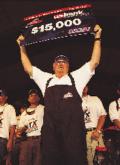 “It’s a pretty good accomplishment,” Gibson said in typical modest fashion. “These co-anglers are a great bunch of guys, and they’re all very good fishermen. Any time you can go out and compete from the back of the boat at the FLW level and win, you’ve got to be pleased.”
“It’s a pretty good accomplishment,” Gibson said in typical modest fashion. “These co-anglers are a great bunch of guys, and they’re all very good fishermen. Any time you can go out and compete from the back of the boat at the FLW level and win, you’ve got to be pleased.”
Gibson admitted, however, that a second title was the farthest thing from his mind during the early morning hours of the final round.
“I didn’t have a fish in the boat by 1 p.m.,” Gibson said. “But then my partner, Koby Kreiger, decided to make a change, and when we got to our new spot, things started to pick up. In the end, I had four bites and caught all four fish.”
Gibson said he targeted largemouth bass along main river currents using a 1/4-ounce Arkansas Hog Caller jig with a green watermelon Zoom Junior Chunk trailer.
Establishing a legacy
With three top-10 finishes in 2001, two top-20 finishes in 2002 and two first-place co-angler titles on the FLW Tour, Gibson – who has suffered a series of back ailments over the years – proved once again that he can more than hold his own against the young guns on the tour.
“I’ll be 65 on July 23, and with 35 years of fishing experience, I understand how to fish out of the back of the boat,” Gibson said. “When I make the top 20, I know what to do. It’s crunch time for me. Some people worry about the other anglers, but I always look at it as me competing against the fish, and I think that helps me.”
As far as the prize money goes – and Gibson has won his fair share of that as well – the native of Bryant, Ark., says it’s all in a day’s work.
“The money is nice, but I just love to go out there and go fishing,” he said. “If there wasn’t any money involved, I’d still be here.”
– Gary Mortenson contributed to this story.
